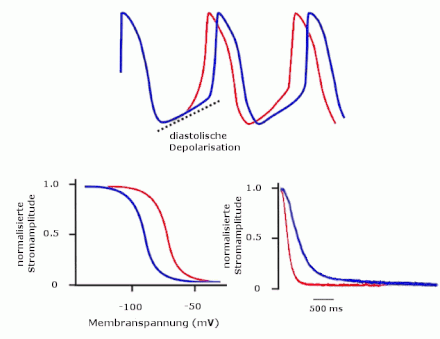Pacemaker potential
A pacemaker potential is an action potential of pacemaker cells (e.g. the sinus node in the heart ).
Origin in the heart
The heartbeat is generated in a special tissue called the sinus node. This is located in the right atrium near the venous inflow. The pacemaker cells of the sinus node do not have a constant resting potential like nerve cells or heart muscle cells . After repolarization of the cell membrane to −60 mV ( also: maximum diastolic potential , since the heart is in diastole at this time ), cations flow through HCN channels , which increases the membrane potential again. This process is also called diastolic depolarization . The otherwise usual, constant rest value between the individual action potentials is missing here. Voltage-dependent calcium channels open from a membrane potential of −40 mV . The calcium influx then leads to the action potential. The membrane then repolarizes itself again by opening potassium channels and the next diastolic depolarization follows.
Influences of the vegetative nervous system
The autonomic nervous system acts chronotropically on pacemaker cells of the heart . This describes the influence on the heart rate. A distinction is made between positive chronotropy, an increase in heart rate, and negative chronotropy, a decrease in heart rate. Typically, the sympathetic nervous system has a positive and chronotropic effect, the parasympathetic nervous system.
The first phase of the pacemaker potential, the diastolic depolarization, is decisive for the corresponding effect. During this phase, the membrane potential becomes more positive until finally corresponding ion channels open, which trigger the action potential via an ion current. Under the influence of adrenaline through the action of the sympathetic nervous system, the diastolic depolarization is steeper. The threshold value is reached faster, the potential frequency increases, and with it the heart rate. Under the influence of the parasympathetic nervous system, the conductivity of the potassium channels is increased, which counteracts calcium depolarization. This increases the diastolic depolarization and decreases the heart rate.
Individual evidence
- ^ Marlen Petersen: Cardiovascular system . In: Michael Gekle u. a. (Ed.): Pocket textbook Physiology . Thieme Verlag, Stuttgart 2010, ISBN 978-3-13-144981-8 , p. 146 ff .
